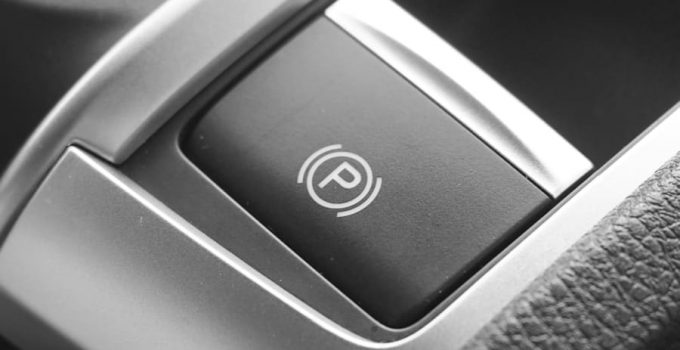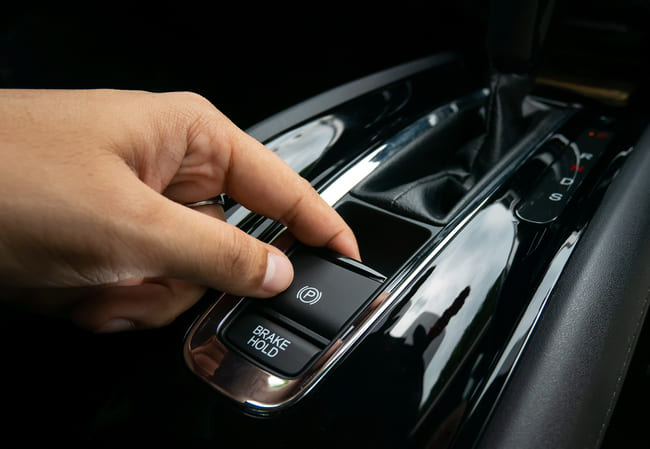
Comfort at the highest level is the motto when it comes to the development of modern vehicles. This is why the electric parking brake, or EFB for short, is increasingly replacing the classic handbrake. In this article you will learn how the electric parking brake differs from the handbrake or the brake pedal and what new functions it brings with it. We explain the structure and present the existing variants. We also look into the question of maintenance costs and round off the article with tips on what to consider when it comes to electric parking brakes.
Functional range

First things first: how does the electric parking brake work? Unlike the mechanical parking brake, the electric parking brake is activated at the push of a button. Depending on the manufacturer, this is even possible automatically – for example when switching off the engine or opening the driver's door. It can also be released via the switch or automatically by pressing the accelerator pedal.
In addition to the typical parking brake function, the electric parking brake also fulfills other functions thanks to its networking with other vehicle systems: Some models offer the so-called auto-hold function. This stores the last braking pressure applied and thus prevents the vehicle from rolling away unintentionally while driving while your foot is switching from the brake pedal to the accelerator pedal. This is particularly useful in stop-and-go traffic or when stopping, such as in a traffic jam, at a traffic light or at a railroad crossing. Another integrated function is Hill Start Assist, which prevents the car from rolling backwards on inclines. On vehicles with a manual transmission, the electric parking brake only opens when there is sufficient torque.
If the electric parking brake is also activated while driving, the emergency braking function comes into play in conjunction with the electronic stability control. Similar to the anti-lock braking system (ABS), the vehicle is braked at intervals to prevent the vehicle from swerving due to a locked rear axle.
In addition, the lining thickness of the brakes is checked regularly, for example at intervals of approx. 500 km, by means of a brake wear check, in which the distance covered by the brake lining and the lining thickness are calculated. This way the driver knows when a replacement is necessary.
Superstructure
In the mechanical variant of the parking brake, the brake force is transmitted from the brake lever via cables to the rear axle, which is mostly fitted with disc brakes these days. Here the driver decides how hard the handbrake is applied. Electric parking brakes, on the other hand, are driven by a so-called servomotor, i.e. a drive unit consisting of an electric motor and a gearbox. The actuator, as it is known in the art, is responsible for putting the control signals into practice and moves the brake piston in the caliper so that the brake pads are pressed against the brake disc and the braking force occurs. The temperature of the brake discs is registered and, if necessary, the braking force is compensated accordingly.
In principle, two graded versions of electric parking brake systems are used in vehicle production, which differ from each other in the scope of their electric drive. First of all, it should be said that none of the braking systems presented will work if the battery is empty. (Some manufacturers offer an emergency release function for this case.) On the one hand, there are electromechanical parking brakes that act like mechanical parking brakes with cable pulls, but transmit the clamping force to the rear axles by means of an electric motor (cable puller system). In short, this is an electrified cable actuation. In the case of brake systems without a cable, the initially mentioned motor-gear units are used on the rear brake calipers (motor on caliper system). Keyword retrofitting: Existing cable pull systems can be upgraded to electric parking brakes as an add-on solution with the cable puller variant.
In addition, the electric parking brake has a control unit for regulation, control and diagnosis. An actuating button enables activation or deactivation of the electric parking brake. Depending on the range of functions, the system is also equipped with additional sensors and buttons for activating traction aids.
Maintenance and troubleshooting
Compared to mechanical parking brakes, electric parking brakes without a cable system are generally less susceptible to faults, since there are no handbrake cables that can freeze or tear, as is the case with handbrakes. However, if maintenance is required, the car should first be tested on a roller brake tester to check the general braking effect. It should be noted that different deviations are permitted for the braking force on the wheels of an axle. For example, the difference in the braking effect on both sides of the axle in the upper area immediately before the locking limit for parking brakes that can be applied while driving and for trailers may not exceed 50%, based on the higher value, and for other vehicles be a maximum of 95%.
If there is no error in the initial visual inspection and mechanics, a diagnostic device provides information about other possible errors in the electronics and control. The error memory is read out and checked for faults.
If the brake pads have to be changed, for example due to wear, the driver is informed by a brake pad wear indicator. To replace the brake pads, the electric parking brake or the brake piston must be retracted. In addition to the diagnostic devices, there are also special brake reset devices for opening and resetting the electric parking brake.
It can often happen that the servomotor is affected because it is not housed under a protective cover but is directly exposed to the weather conditions. Depending on the vehicle brand, only the servomotor or the entire brake caliper unit has to be replaced in this case.
Conclusion
If you don't want to do without the latest vehicle equipment, the electric parking brake now offers an even safer and more comfortable driving experience. Greater space savings and less handling by the driver, plus integrated safety functions speak for themselves. The maintenance effort is lower compared to the mechanical handbrake, but if the worst comes to the worst, it weighs more heavily in terms of costs. With the increase in built-in technology, modern diagnostic tools are also necessary.
A tip from CarTipsandmore: If it is a car with a manual transmission, it is advisable to use the parking brake as well as the first one Engage gear when the front of the vehicle is facing uphill. If the front of the vehicle is facing the valley, reverse gear should be engaged.
A special case arises when the car is parked with the parking brake on when the temperature is below zero. While frost is less of a risk on modern cars, again checking with the owner's manual to turn off the automatic activation of the electric parking brake and using wheel chocks to secure the wheels instead. If available, the car should preferably be parked in a garage or other place where it is protected from frost at such temperatures.
